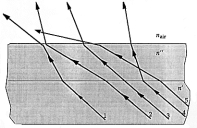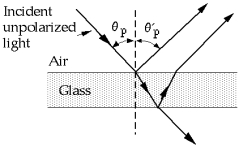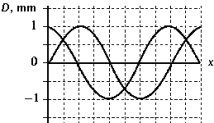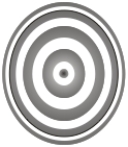A) 4.1 × 10-5 m
B) 1.5 × 10-5 m
C) 3.0 × 10-5 m
D) 8.2 × 10-5 m
E) 3.8 × 10-5 m
G) B) and E)
Correct Answer

verified
Correct Answer
verified
Multiple Choice
Which, if any, of the following conditions is not necessary for the light waves from two sources to be coherent?
A) They must have the same frequency.
B) They must have the same amplitude.
C) They must have the same wavelength.
D) They must have a constant phase difference.
E) All of these conditions are necessary.
G) D) and E)
Correct Answer

verified
Correct Answer
verified
Multiple Choice
 Light travels in a medium of index of refraction n', passes into a medium of index n", where n" > n', and then into air, where nair < n' < n". The ray that correctly shows the light path is
Light travels in a medium of index of refraction n', passes into a medium of index n", where n" > n', and then into air, where nair < n' < n". The ray that correctly shows the light path is
A) 1.
B) 2.
C) 3.
D) 4.
E) 5.
G) A) and C)
Correct Answer

verified
Correct Answer
verified
Multiple Choice
You create a wedge-shaped film of air between two flat plates of glass 2.5 cm wide by laying one on top of the other and placing a small slip of paper 1.0 mm thick between their edges at one end. You illuminate the glass plates with normally incident monochromatic light of unknown wavelength. Observing the reflection, you see dark fringes at both ends of the plates. Between the ends you see three other dark fringes. What is the wavelength of the incident light?
A) 250 nm
B) 400 nm
C) 440 nm
D) 500 nm
E) 620 nm
G) B) and C)
Correct Answer

verified
Correct Answer
verified
Multiple Choice
The index of refraction of water is 1.33. The angle of incidence for maximum polarization by reflection is approximately
A) 57º.
B) 53º.
C) 45º.
D) 37º.
E) 33º.
G) A) and C)
Correct Answer

verified
Correct Answer
verified
Multiple Choice
The optical phenomenon that is usually cited as demonstrating the transverse wave nature of light is
A) dispersion.
B) interference.
C) reflection.
D) polarization.
E) refraction.
G) C) and E)
Correct Answer

verified
Correct Answer
verified
Multiple Choice
You set two parallel slits 0.1 mm apart at a distance of 2 m from a screen and illuminate them with light of wavelength 450 nm. The distance between a bright spot in the interference pattern and the dark spot adjacent to it is
A) 0.560 mm.
B) 1.12 mm.
C) 2.25 mm.
D) 4.50 mm.
E) 9.00 mm.
G) B) and E)
Correct Answer

verified
Correct Answer
verified
Multiple Choice
 If the index of refraction of the glass plate shown is 1.45, the angle of incidence
If the index of refraction of the glass plate shown is 1.45, the angle of incidence  that will cause the unpolarized light to be reflected as completely plane-polarized light is
that will cause the unpolarized light to be reflected as completely plane-polarized light is
A) 8.25º.
B) 34.6º.
C) 45.0º.
D) 55.4º.
E) 81.7º.
G) A) and B)
Correct Answer

verified
Correct Answer
verified
Multiple Choice
Light of wavelength 450 nm is incident on a narrow slit. The diffraction pattern is observed on a screen 5.0 m from the slit, and the central maximum is observed to have a width of 22 cm. What is the width of the slit?
A) 4.5 µm
B) 5.0 µm
C) 10 µm
D) 20 µm
E) 0.20 µm
G) C) and E)
Correct Answer

verified
D
Correct Answer
verified
Multiple Choice
As the width of the slit producing a single-slit diffraction pattern is slowly and steadily reduced always remaining larger than the wavelength of the light) , the diffraction pattern
A) slowly and steadily gets wider.
B) slowly and steadily gets brighter.
C) does not change because the wavelength of the light does not change.
D) slowly and steadily gets narrower.
E) None of these is correct.
G) All of the above
Correct Answer

verified
Correct Answer
verified
Multiple Choice
 The phase difference for the two waves shown in the figure is
The phase difference for the two waves shown in the figure is
A) 2π.
B) π.
C) 3π/2.
D) π/2.
E) It is not possible to answer this question without additional information.
G) B) and E)
Correct Answer

verified
Correct Answer
verified
Multiple Choice
A helium-neon laser emits light of wavelength 632.8 nm and has a power output of 1.5 mW. How many photons are emitted per second by this laser?
A) 1.34 × 1014
B) 2.56 × 1015
C) 3.09 × 1015
D) 4.22 × 1015
E) 4.78 × 1015
G) A) and E)
Correct Answer

verified
E
Correct Answer
verified
Multiple Choice
A small beam of monochromatic light in air is incident on a large plate of glass with plane-parallel sides at an angle of 30º. The index of refraction of the glass plate for this wavelength is 1.50. The angle of emergence of the light on the far side of the plate is approximately
A) 30º.
B) 45º.
C) 20º.
D) the angle whose sine is 1/3.
E) 60º.
G) All of the above
Correct Answer

verified
Correct Answer
verified
Multiple Choice
You see a fish in water at an apparent depth of 1.83 m. The actual depth of the fish, if the index of refraction of the water relative to air is 4/3, must be
A) 3.81 cm.
B) 61.0 cm.
C) 1.37 m.
D) 1.83 m.
E) 2.44 m.
G) A) and B)
Correct Answer

verified
Correct Answer
verified
Multiple Choice
You dip a wire loop into soapy water n = 1.33) and hold it up vertically to look at the soap film in white light. The soap film looks dark at the top because it has sagged, and its thickness there is nearly zero, causing the reflected wavelengths to interfere destructively. Partway down the loop you see the first red band of the reflected white light. What is the thickness of the soap film there? Take the wavelength of red light to be 680 nm.)
A) 130 nm
B) 170 nm
C) 220 nm
D) 250 nm
E) 340 nm
G) B) and D)
Correct Answer

verified
Correct Answer
verified
Multiple Choice
A helium-neon laser emits light of wavelength 632.8 nm and has a power output of 3 mW. How many photons are emitted per second by this laser?
A) 9.55 × 1014
B) 9.55 × 1015
C) 8.24 × 1015
D) 6.53 × 1015
E) 4.78 × 1015
G) All of the above
Correct Answer

verified
Correct Answer
verified
Multiple Choice
 A broad spectrum of light λ = 550 nm) illuminates normally a thin wedge of glass n = 1.50) . If the thick edge of the glass is 0.02 mm, the number of dark fringes observed is
A broad spectrum of light λ = 550 nm) illuminates normally a thin wedge of glass n = 1.50) . If the thick edge of the glass is 0.02 mm, the number of dark fringes observed is
A) 109.
B) 99.
C) 73.
D) 55.
E) 33.
G) A) and C)
Correct Answer

verified
Correct Answer
verified
Multiple Choice
An "X" is marked on the bottom of a glass container. A microscope is adjusted so that it is focused on the "X." A liquid is now poured into the glass to a depth of 6.00 cm. If the microscope has to be backed up by a distance of 1.50 cm to refocus on the "X," then calculate the refractive index of the liquid.
A) 1.25
B) 4.00
C) 1.33
D) 0.75
E) 3.00
G) A) and B)
Correct Answer

verified
Correct Answer
verified
Multiple Choice
You illuminate two slits 0.50 mm apart with light of wavelength 555 nm and observe interference fringes on a screen 6.0 m away. What is the spacing between the fringes on the screen?
A) 4.5 mm
B) 3.3 mm
C) 6.7 mm
D) 10 mm
E) 5.0 mm
G) B) and C)
Correct Answer

verified
Correct Answer
verified
Multiple Choice
 The interference pattern is from a lens placed on a flat reflecting surface illuminated using a monochromatic light from above. From the pattern one can conclude that the lens
The interference pattern is from a lens placed on a flat reflecting surface illuminated using a monochromatic light from above. From the pattern one can conclude that the lens
A) is more curved on the left and right sides compared to top and bottom.
B) is more curved on the top and bottom compared to the left and right sides.
C) has a spherical surface.
D) has a concave surface.
E) is none of the above.
G) A) and B)
Correct Answer

verified
B
Correct Answer
verified
Showing 1 - 20 of 182
Related Exams